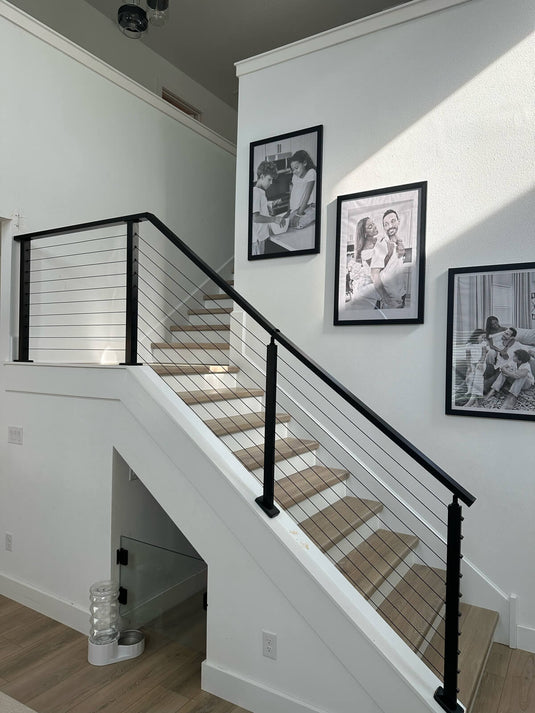TABLE OF CONTENTS
Horizontal vs. Vertical Cable Railings: What's Best for Your Deck?
Cable railings have become a popular choice for decks, offering a modern look and clear views. These railing systems, especially prominent in modern architecture, come mainly in two orientations: horizontal and vertical. Each style offers a distinct set of benefits and concerns, catering to various preferences and functional requirements. Knowing the differences is key to choosing the right one for your home. In this article, we will explore the pros and cons of both horizontal and vertical cable railings, guiding you through the essential factors that should influence your choice.
Horizontal Cable Railings

Horizontal cable railings are characterized by their long cables running parallel to each other along the deck perimeter, offering a minimalist and modern visual appeal. They serve as a nearly invisible fence line from afar, ensuring that nothing obstructs the sweeping views of open landscapes or glittering urban skylines.
The pros of incorporating horizontal cable railings into your deck design are numerous:
●Unobstructed Views: The thin profile of the cables ensures that whether you're gazing at rolling hills or bustling city vistas, your view remains pristine and unmarred.
●Aesthetic Integration: These railings have a knack for blending seamlessly into contemporary urban environments as well as natural settings, enhancing the architectural elements rather than overpowering them.
●Amplifies Space: For expansive decks, horizontal lines have a way of visually extending the space, making it appear wider and more open.
However, there are cons associated with horizontal cable railings that one must consider:
●Safety Concerns: For families with young children or pets, the horizontal orientation might pose a risk as they can potentially climb over them, leading to dangerous falls. (Note:To prevent such accidents, it is crucial to adhere to local regulatory safety requirements for the installation of cable railings. This includes ensuring adequate cable tension and spacing. Additionally, regular maintenance to tighten the cables is important for ongoing safety.)
●Installation: The alignment of horizontal cables requires precise tension to maintain both aesthetic appeal and safety standards, which can be intricate and time-consuming.
●View Versatility: In certain landscapes or viewing angles, horizontal lines may not always be the best fit—especially if there is a desire to frame specific aspects of the scenery.
By weighing these pros and cons, homeowners can better evaluate whether horizontal cable railings are the right fit for their decking project, taking into account aesthetics, safety, and installation factors.
Vertical Cable Railings
Vertical cable railings offer an alternative aesthetic to the horizontal orientation, with cables that extend upright between deck posts. This configuration can become a design feature in itself, attracting attention with its bold lines and contributing to a deck's overall style.
With their crisp vertical lines, these railings impart a sense of order and structure to the space. The vertical cables create a visually striking profile that is more pronounced than the horizontal option, often catching the eye and becoming a deliberate part of your deck's visual narrative.
Pros
The benefits of opting for vertical cable railings are varied and can greatly enhance the look and functionality of your outdoor living area:
●Open Yet Styled Views: While still permitting largely unobstructed views, vertical railings add a stylistic element that can elevate the overall aesthetic of your space.
●Enhanced Safety: The vertical design is less climbable than horizontal railings, making it a safer choice for households with children or pets.
●Complements Modern Design: These railings can beautifully complement minimalist modern homes, providing clean lines that accentuate the architecture without overpowering it.
●Feature Emphasis: By directing the gaze upward, vertical railings can highlight architectural features like high ceilings or grand facades.
●Installation Simplicity: In some installations, vertical cables may be easier to work with as they often don't require the same level of tension as horizontal cables, simplifying the process.
Cons
However, there are also downsides to consider with vertical cable railings:
●Potential to Overwhelm: In areas where the landscape or urban skyline is already dense, adding vertical lines might contribute to a cluttered view.
●Visibility: Unlike their horizontal counterparts, vertical railings are more noticeable and may slightly impede panoramic views from certain angles.
Each aspect of vertical cable railings should be carefully considered against your deck's specific needs and your personal tastes. Their unique combination of style and safety makes them a compelling choice for many, but understanding their visual impact within your space is essential.

Key Factors When Choosing Between Horizontal and Vertical Cable Railings
When selecting the perfect cable railing orientation for your deck, it isn't just about picking a style. The decision should be the result of careful consideration of various key factors that will impact not only the look and feel of your outdoor space but its functionality and safety as well.
Safety Considerations
The foremost concern for many homeowners is the safety of their family members, particularly children and pets. Horizontal railings, while aesthetically pleasing, can unwittingly become ladders for adventurous little ones or agile pets, leading to potential falls. Vertical railings offer less opportunity for climbing and may provide greater peace of mind for those concerned with safety.
Aesthetic Preferences
Your personal taste in design will significantly influence your choice between horizontal and vertical cable railings. Horizontal lines are synonymous with sleek, modern aesthetics, providing a subtle complement to contemporary designs. On the other hand, vertical railings add a distinctive architectural element that can serve as a striking focal point, enhancing the overall character of a space.
Type of View/Positioning
The type of view from your deck also plays a critical role in your decision. Horizontal railings are best suited for maximizing panoramic vistas, as they minimize visual interruptions. In contrast, vertical railings are particularly effective when wanting to draw attention to the vertical elements of a view, such as tall trees or buildings, making them an integral part of the landscape.
Architecture and Setting
Consider your home's architectural style and the surrounding environment. Horizontal cables are a natural fit for decks set against modern cityscapes or within minimalist designs, where the focus is on creating open, uncluttered spaces. Vertical cables may better complement settings that call for defined segments or where the goal is to integrate the railing into the architectural details, highlighting specific features of the design.
Deck Space and Uses
The intended use and available space on your deck should guide your railing selection. Horizontal railings can enhance the feeling of width and spaciousness, ideal for wide decks designed for gatherings. Conversely, vertical railings can help define different areas within a deck, creating cozy, intimate spaces within a larger context.
Ease of Installation
Installation complexity may also affect your choice. Horizontal railings often entail more intricate installation due to the need for perfect tension across longer spans to maintain both appearance and function. Vertical railings might offer a simpler installation process, with some systems designed for easier setup, making them a practical option for DIY enthusiasts or when looking to reduce installation costs.
Pick Your Deck's Perfect Railing
Both options offer distinct aesthetic appeals and functional benefits when choosing between horizontal and vertical cable railings for your deck. Horizontal railings are unbeatable for panoramic views and a modern look but raise safety concerns for children and pets. Vertical railings counter these issues with enhanced safety and a bold design statement, though they may be more noticeable. Considerations for selection include family safety, design preference, view type, architectural harmony, deck usage, and installation requirements. Your decision should align with your lifestyle and the vision you have for your outdoor space, ensuring a blend of style, functionality, and peace of mind.




